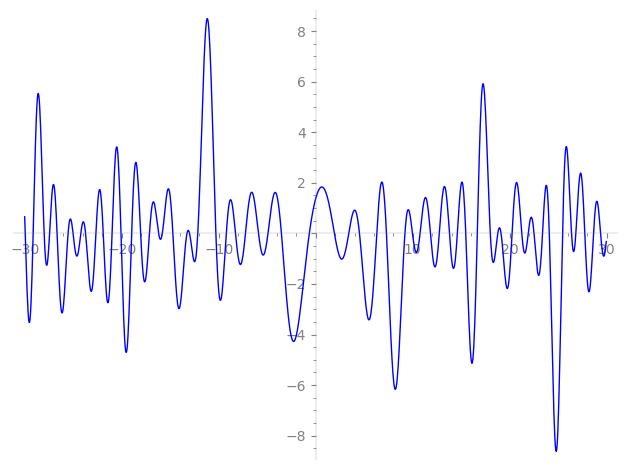| L(s) = 1 | + (0.804 + 2.71i)2-s − 0.717i·3-s + (−6.70 + 4.36i)4-s − 13.2i·5-s + (1.94 − 0.576i)6-s − 11.9·7-s + (−17.2 − 14.6i)8-s + 26.4·9-s + (35.9 − 10.6i)10-s − 20.9i·11-s + (3.12 + 4.81i)12-s − 68.3i·13-s + (−9.60 − 32.3i)14-s − 9.49·15-s + (25.9 − 58.4i)16-s + 17·17-s + ⋯ |
| L(s) = 1 | + (0.284 + 0.958i)2-s − 0.138i·3-s + (−0.838 + 0.545i)4-s − 1.18i·5-s + (0.132 − 0.0392i)6-s − 0.644·7-s + (−0.760 − 0.648i)8-s + 0.980·9-s + (1.13 − 0.336i)10-s − 0.574i·11-s + (0.0752 + 0.115i)12-s − 1.45i·13-s + (−0.183 − 0.618i)14-s − 0.163·15-s + (0.405 − 0.914i)16-s + 0.242·17-s + ⋯ |
\[\begin{aligned}\Lambda(s)=\mathstrut & 136 ^{s/2} \, \Gamma_{\C}(s) \, L(s)\cr =\mathstrut & (0.760 + 0.648i)\, \overline{\Lambda}(4-s) \end{aligned}\]
\[\begin{aligned}\Lambda(s)=\mathstrut & 136 ^{s/2} \, \Gamma_{\C}(s+3/2) \, L(s)\cr =\mathstrut & (0.760 + 0.648i)\, \overline{\Lambda}(1-s) \end{aligned}\]
Particular Values
| \(L(2)\) |
\(\approx\) |
\(1.29742 - 0.478009i\) |
| \(L(\frac12)\) |
\(\approx\) |
\(1.29742 - 0.478009i\) |
| \(L(\frac{5}{2})\) |
|
not available |
| \(L(1)\) |
|
not available |
\(L(s) = \displaystyle \prod_{p} F_p(p^{-s})^{-1} \)
| $p$ | $F_p(T)$ |
|---|
| bad | 2 | \( 1 + (-0.804 - 2.71i)T \) |
| 17 | \( 1 - 17T \) |
| good | 3 | \( 1 + 0.717iT - 27T^{2} \) |
| 5 | \( 1 + 13.2iT - 125T^{2} \) |
| 7 | \( 1 + 11.9T + 343T^{2} \) |
| 11 | \( 1 + 20.9iT - 1.33e3T^{2} \) |
| 13 | \( 1 + 68.3iT - 2.19e3T^{2} \) |
| 19 | \( 1 + 20.2iT - 6.85e3T^{2} \) |
| 23 | \( 1 + 13.6T + 1.21e4T^{2} \) |
| 29 | \( 1 - 29.1iT - 2.43e4T^{2} \) |
| 31 | \( 1 + 151.T + 2.97e4T^{2} \) |
| 37 | \( 1 + 61.2iT - 5.06e4T^{2} \) |
| 41 | \( 1 + 145.T + 6.89e4T^{2} \) |
| 43 | \( 1 + 53.1iT - 7.95e4T^{2} \) |
| 47 | \( 1 - 290.T + 1.03e5T^{2} \) |
| 53 | \( 1 + 510. iT - 1.48e5T^{2} \) |
| 59 | \( 1 - 536. iT - 2.05e5T^{2} \) |
| 61 | \( 1 + 437. iT - 2.26e5T^{2} \) |
| 67 | \( 1 - 723. iT - 3.00e5T^{2} \) |
| 71 | \( 1 + 1.01e3T + 3.57e5T^{2} \) |
| 73 | \( 1 - 366.T + 3.89e5T^{2} \) |
| 79 | \( 1 - 230.T + 4.93e5T^{2} \) |
| 83 | \( 1 + 155. iT - 5.71e5T^{2} \) |
| 89 | \( 1 - 1.05e3T + 7.04e5T^{2} \) |
| 97 | \( 1 - 1.48e3T + 9.12e5T^{2} \) |
| show more | |
| show less | |
\(L(s) = \displaystyle\prod_p \ \prod_{j=1}^{2} (1 - \alpha_{j,p}\, p^{-s})^{-1}\)
Imaginary part of the first few zeros on the critical line
−13.00934303092274609339212155572, −12.15832487544386016252322774064, −10.29196470723576383383631373598, −9.217324599608867637654518467119, −8.270766580517509316930057734018, −7.24167272941003494563792161089, −5.89803512323427360901055398053, −4.92022868862958311287266721249, −3.53519312918741154910740456404, −0.66030697406842044037969834958,
1.92461630628918970716077740888, 3.40593183256287727138040513879, 4.50854085902393332349570938203, 6.28925246965710291674692413064, 7.28999203514389227730207860948, 9.195106898398478704766018597250, 9.973628324730360348288396165120, 10.75590123935357998645863875477, 11.82409281297870515271085528298, 12.73746759891864744341591676438

